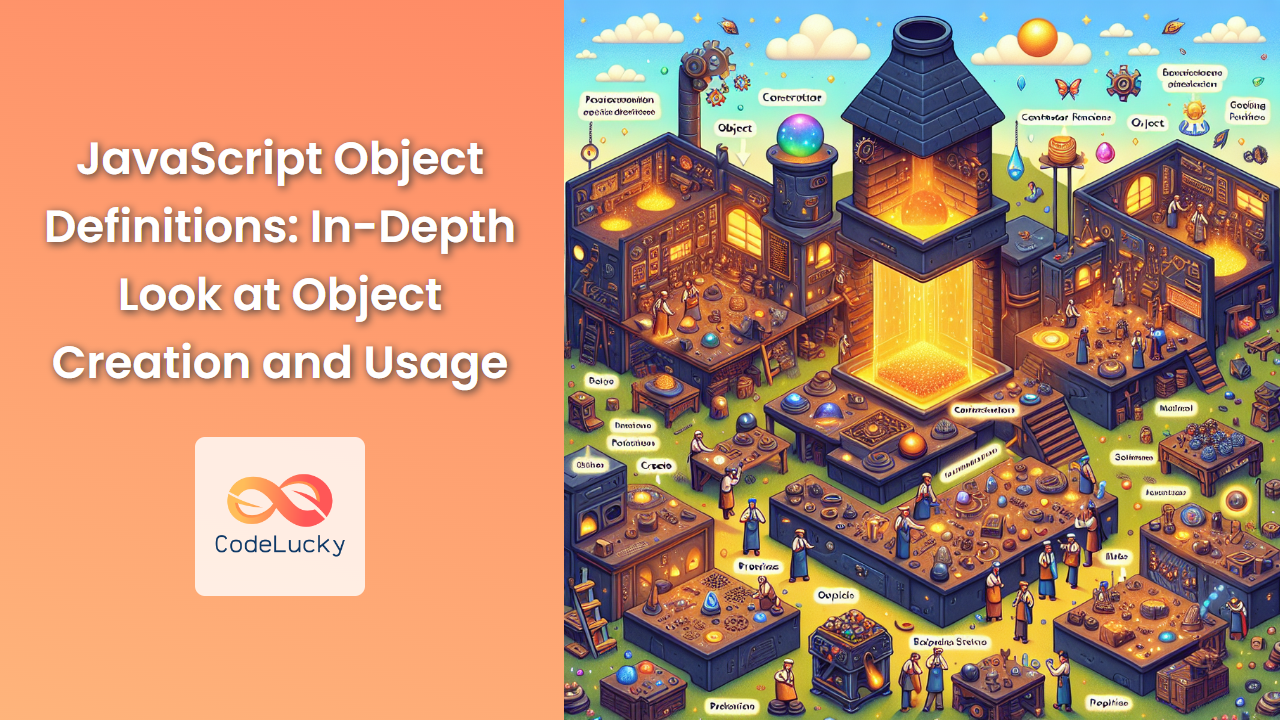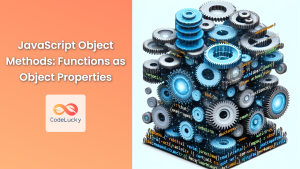JavaScript objects are fundamental to the language, serving as the building blocks for complex data structures and providing a way to organize and manipulate related data and functionality. In this comprehensive guide, we'll dive deep into the world of JavaScript objects, exploring various methods of object creation, manipulation, and advanced usage.
Understanding JavaScript Objects
At its core, a JavaScript object is a collection of key-value pairs, where each key is a string (or Symbol) and each value can be any valid JavaScript data type, including other objects or functions. This flexibility makes objects incredibly versatile and powerful.
Let's start with a basic example:
const person = {
name: "Alice",
age: 30,
city: "New York"
};
console.log(person.name); // Output: Alice
console.log(person["age"]); // Output: 30
In this example, we've created a simple person object with three properties: name, age, and city. We can access these properties using dot notation (person.name) or bracket notation (person["age"]).
🔑 Key Point: Objects in JavaScript are dynamic, meaning you can add, modify, or delete properties at any time.
Object Creation Methods
JavaScript offers several ways to create objects. Let's explore each method in detail.
1. Object Literal Notation
The object literal notation is the most straightforward way to create an object. We've already seen an example of this above. Here's a more complex example:
const car = {
make: "Toyota",
model: "Camry",
year: 2022,
features: ["Bluetooth", "Backup Camera", "Lane Assist"],
start: function() {
console.log("Engine started!");
}
};
car.start(); // Output: Engine started!
console.log(car.features[1]); // Output: Backup Camera
In this example, we've created a car object with various property types, including an array and a method.
2. Object Constructor Function
Constructor functions allow us to create multiple objects with the same structure and behavior. They're particularly useful when you need to create many similar objects.
function Book(title, author, year) {
this.title = title;
this.author = author;
this.year = year;
this.getSummary = function() {
return `${this.title} was written by ${this.author} in ${this.year}`;
};
}
const book1 = new Book("1984", "George Orwell", 1949);
const book2 = new Book("To Kill a Mockingbird", "Harper Lee", 1960);
console.log(book1.getSummary());
// Output: 1984 was written by George Orwell in 1949
console.log(book2.getSummary());
// Output: To Kill a Mockingbird was written by Harper Lee in 1960
In this example, Book is a constructor function. We use the new keyword to create new Book objects, each with its own set of properties and methods.
3. Object.create() Method
The Object.create() method creates a new object, using an existing object as the prototype of the newly created object. This method is powerful for implementing inheritance in JavaScript.
const vehiclePrototype = {
init: function(make, model) {
this.make = make;
this.model = model;
},
getInfo: function() {
return `This is a ${this.make} ${this.model}`;
}
};
const myCar = Object.create(vehiclePrototype);
myCar.init("Honda", "Civic");
console.log(myCar.getInfo()); // Output: This is a Honda Civic
const myTruck = Object.create(vehiclePrototype);
myTruck.init("Ford", "F-150");
console.log(myTruck.getInfo()); // Output: This is a Ford F-150
In this example, vehiclePrototype serves as a template for creating vehicle objects. Both myCar and myTruck inherit properties and methods from vehiclePrototype.
4. ES6 Class Syntax
ES6 introduced a more familiar class-based syntax for creating objects, which is syntactic sugar over JavaScript's existing prototype-based inheritance.
class Animal {
constructor(name, species) {
this.name = name;
this.species = species;
}
makeSound() {
console.log("Some generic animal sound");
}
}
class Dog extends Animal {
constructor(name) {
super(name, "Canis lupus familiaris");
}
makeSound() {
console.log("Woof! Woof!");
}
}
const genericAnimal = new Animal("Generic", "Animalus genericus");
genericAnimal.makeSound(); // Output: Some generic animal sound
const myDog = new Dog("Buddy");
console.log(myDog.species); // Output: Canis lupus familiaris
myDog.makeSound(); // Output: Woof! Woof!
This example demonstrates how to use ES6 classes to create objects and implement inheritance. The Dog class extends the Animal class, inheriting its properties and methods, and overriding the makeSound method.
Working with Object Properties
Now that we've covered various ways to create objects, let's dive deeper into working with object properties.
Adding and Modifying Properties
You can add or modify properties of an object at any time:
const user = {
name: "John Doe",
email: "[email protected]"
};
// Adding a new property
user.age = 30;
// Modifying an existing property
user.name = "Jane Doe";
console.log(user);
// Output: { name: 'Jane Doe', email: '[email protected]', age: 30 }
Deleting Properties
The delete operator allows you to remove a property from an object:
const product = {
name: "Laptop",
price: 999,
brand: "TechCo"
};
delete product.brand;
console.log(product);
// Output: { name: 'Laptop', price: 999 }
Property Descriptors
JavaScript provides a way to define more specific behavior for object properties using property descriptors. These allow you to control whether a property can be changed, deleted, or enumerated.
const person = {
firstName: "Alice",
lastName: "Johnson"
};
Object.defineProperty(person, 'fullName', {
get: function() {
return `${this.firstName} ${this.lastName}`;
},
set: function(value) {
[this.firstName, this.lastName] = value.split(' ');
},
enumerable: true,
configurable: true
});
console.log(person.fullName); // Output: Alice Johnson
person.fullName = "Bob Smith";
console.log(person.firstName); // Output: Bob
console.log(person.lastName); // Output: Smith
In this example, we've defined a fullName property with custom getter and setter functions. The enumerable flag determines if the property shows up in for...in loops, and configurable determines if the property can be deleted or its attributes modified.
Advanced Object Techniques
Let's explore some more advanced techniques for working with objects in JavaScript.
Object Destructuring
Object destructuring allows you to extract multiple properties from an object and assign them to variables in a single statement:
const employee = {
id: 12345,
name: "Sarah Parker",
position: "Software Engineer",
department: "IT"
};
const { name, position } = employee;
console.log(name); // Output: Sarah Parker
console.log(position); // Output: Software Engineer
You can also use destructuring with default values and alias names:
const { id, department, salary = 50000, name: employeeName } = employee;
console.log(id); // Output: 12345
console.log(department); // Output: IT
console.log(salary); // Output: 50000 (default value)
console.log(employeeName); // Output: Sarah Parker
Spread Operator with Objects
The spread operator (...) can be used to create shallow copies of objects or merge multiple objects:
const baseConfig = {
apiUrl: "https://api.example.com",
timeout: 5000
};
const devConfig = {
...baseConfig,
logLevel: "debug"
};
console.log(devConfig);
// Output: { apiUrl: 'https://api.example.com', timeout: 5000, logLevel: 'debug' }
const prodConfig = {
...baseConfig,
logLevel: "error",
timeout: 3000
};
console.log(prodConfig);
// Output: { apiUrl: 'https://api.example.com', timeout: 3000, logLevel: 'error' }
Object Methods
JavaScript provides several built-in methods for working with objects. Let's explore a few:
Object.keys(), Object.values(), and Object.entries()
These methods allow you to work with an object's keys, values, or both:
const person = {
name: "Charlie Brown",
age: 25,
occupation: "Student"
};
console.log(Object.keys(person));
// Output: ['name', 'age', 'occupation']
console.log(Object.values(person));
// Output: ['Charlie Brown', 25, 'Student']
console.log(Object.entries(person));
// Output: [['name', 'Charlie Brown'], ['age', 25], ['occupation', 'Student']]
Object.freeze() and Object.seal()
These methods provide ways to make objects immutable to varying degrees:
const frozenObj = Object.freeze({
prop: 42
});
frozenObj.prop = 33; // Fails silently in non-strict mode
console.log(frozenObj.prop); // Output: 42
const sealedObj = Object.seal({
prop: 42
});
sealedObj.prop = 33; // This works
sealedObj.newProp = "Hello"; // This fails silently in non-strict mode
console.log(sealedObj.prop); // Output: 33
console.log(sealedObj.newProp); // Output: undefined
Object.freeze() prevents any changes to the object, while Object.seal() allows existing properties to be modified but prevents adding or deleting properties.
Prototypes and Inheritance
JavaScript uses a prototype-based inheritance model. Every object in JavaScript has a hidden [[Prototype]] property that links to another object or null. This forms the prototype chain.
function Animal(name) {
this.name = name;
}
Animal.prototype.speak = function() {
console.log(`${this.name} makes a sound.`);
};
function Dog(name) {
Animal.call(this, name);
}
Dog.prototype = Object.create(Animal.prototype);
Dog.prototype.constructor = Dog;
Dog.prototype.bark = function() {
console.log(`${this.name} barks.`);
};
const dog = new Dog("Rex");
dog.speak(); // Output: Rex makes a sound.
dog.bark(); // Output: Rex barks.
In this example, Dog inherits from Animal. The Dog prototype is set to a new object created from Animal.prototype, establishing the prototype chain.
Conclusion
JavaScript objects are incredibly versatile and powerful. From simple data containers to complex structures with methods and inheritance, objects form the backbone of JavaScript programming. By mastering object creation, manipulation, and advanced techniques, you'll be well-equipped to write efficient, organized, and powerful JavaScript code.
Remember, the key to becoming proficient with JavaScript objects is practice. Experiment with different object creation methods, play with property descriptors, and explore the nuances of prototypal inheritance. As you gain experience, you'll develop an intuitive understanding of when and how to best use objects in your JavaScript projects.
🚀 Pro Tip: Always consider the specific needs of your project when choosing how to create and structure your objects. While ES6 classes provide a familiar syntax for developers coming from class-based languages, prototypal inheritance can offer more flexibility in certain scenarios.
By mastering these concepts, you'll be able to write more efficient, maintainable, and powerful JavaScript code. Happy coding!



















